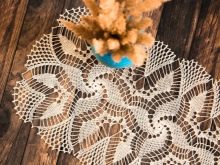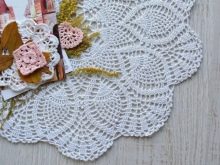How to starch a napkin?

The beauty of openwork napkins is undeniable. Delicate, airy napkins, tablecloths knitted from threads look very beautiful and original. To make the finished product look more impressive and have the required shape, it is advisable to starch it. How to correctly perform a similar procedure using starch and other means will be discussed in this article.
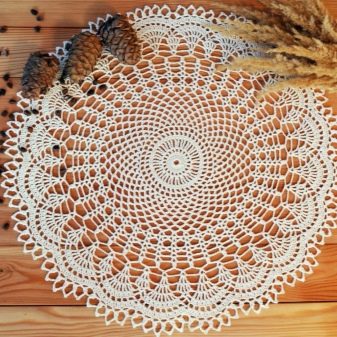
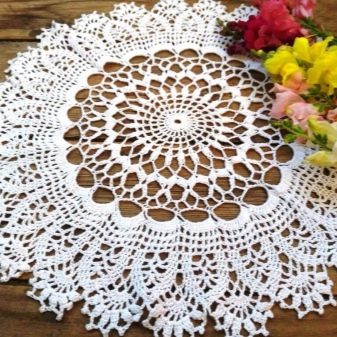
Using potato starch
Although you can buy a wide variety of interior decoration items in the store, many still prefer to use DIY products for these purposes. Hand-made models have not lost their relevance, such decorative ornaments began to be appreciated much more than store options. They add a special atmosphere to the interior and decorate any space. Such crafts look especially relevant in rooms decorated in rustic, rustic styles, as well as Provence style.
Usually openwork napkins are knitted using Iris or Snowflake yarn. Products made from these threads are very delicate and beautiful. Unfortunately, in the process of work, the models lose their shape, the threads become soft, and the napkins themselves look less impressive. To give them the desired shape, it is necessary to starch the finished product.

After processing occurs:
-
an increase in the density of fibers and their elasticity;
-
the product whitens a little;
-
the presence of a protective film prevents the appearance of dust.
In the starched form, the work looks very impressive. They are used not only as a tablecloth or napkins, but also to create pots, decorative vases, containers for sweets.
Processing is recommended for cotton products.These options are easy to starch and will hold their shape for a long time.

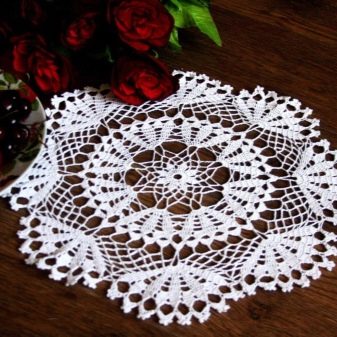
Crafts made from synthetic fibers, as well as linen and wool products, should not be processed, as this can lead to a violation of the structure. In addition, wool or synthetic products are less susceptible to starch. Do not process textiles in dark colors, as whitish streaks and spots often remain on it.
Immediately before the procedure, the products should be washed. Do this in warm water using a hand-wash powder. It is undesirable to rub the napkin strongly, it is enough to slightly crush it, then rinse thoroughly.

After washing the product, starch it. Most often, a solution obtained from potato starch is used for this. The essence of the procedure is quite simple. It is enough to immerse the lace napkin in the paste and leave it there for a few minutes. The use of potato starch will not only give the product a presentable look, but also whiten it. If desired, or in the absence of potato starch, you can use a rice or corn equivalent.
Having chosen these options, it should be remembered that they have a lower viscosity, therefore, when preparing the paste, it is necessary to take more powder.
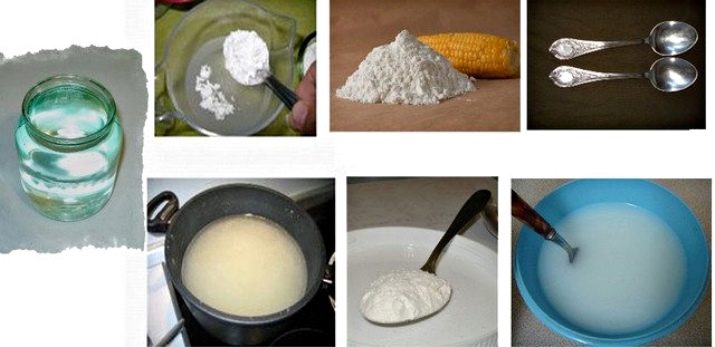
Using different amounts of potato starch, you can get a solution of different consistency.
-
To prepare a soft solution, take water (1 liter) and potato starch (1 tsp). Such a paste is not very saturated. Soaking textiles in it will give a little elasticity, while the ends of the tablecloths or napkins will hang down.
-
To prepare a solution of medium consistency, you need to take 1 tbsp for 1 liter of water. a spoonful of powder. This option is suitable for processing openwork collars, lace, cuffs.
-
To make a hard solution, use 2 large tablespoons of powder and 1 liter of water... This option is suitable for processing various interior crafts created on the basis of crocheting.
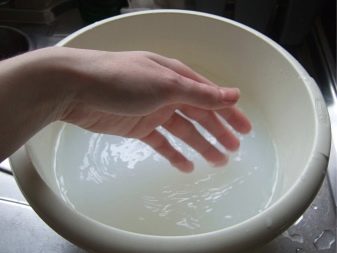
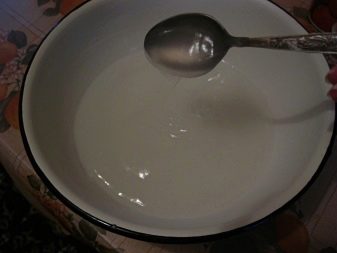
The preparation of a solution for starching products is similar for other options.
To make a paste, you need to follow a series of steps.
-
Take some water and add starch to the container with water. Stir the mixture well and quickly so that no lumps remain there. When they appear, the solution must be filtered. Outwardly, the mixture should look like liquid sour cream.
-
Pour the remaining water into another vessel, and let it boil.... The creamy mass must then be carefully poured into boiling water in a thin stream, stirring thoroughly until the liquid boils again.
-
Turn off the heat and set aside the paste to cool.


The cooled mass to a temperature of 30-35 degrees is used to shape the products into the required shape.
-
To do this, you need to take a bowl and add the cooled mass to it.
-
Dip a napkin into the paste so that it is completely covered with the mixture.
-
Leave it on for a few minutes. The immersion time of the product depends on the thickness of the fibers and their type. For thin threads, the holding time in the mixture is 5-7 minutes. Variants with medium and thick threads stand for 10-15 minutes, respectively.
-
Remove the product from the bowl.
-
Squeeze out a little.


The squeezed napkin is then laid out on a flat surface to dry. Do not wait for the product to dry out. The napkin is shaped before it is completely dry.
Application of other means
At home, you can use other options that can give openwork products a beautiful look and shape.
To starch an openwork product on a table, napkins or curtains, use:
-
salt;
-
milk;
-
sugar;
-
talc;
-
borax;
-
PVA glue;
-
gelatin;
-
aerosols.
Textile processing is carried out according to the scheme indicated above.

Milk
The use of milk will allow you to give the products a matte shade. For this purpose, a low-fat dairy product (1.5%) is more suitable.
To prepare the solution, you need to take half a liter of milk and rice starch (1 tsp.l.).
-
In a container, you need to dilute a small part of cold milk with starch, mix the mass thoroughly.
-
The remaining milk must be boiled and the prepared mixture is poured into it.
-
It is imperative to stir the milk with a spoon when adding the mass.
After removing from heat, the mass is left to cool. Then a napkin is immersed in it and kept for several minutes.


Sugar
Sugar is commonly used for bulking products.
To prepare the mixture, you should take half a liter of water, and prepare 1 tsp. starch and 2 tbsp. tablespoons of sugar.
Algorithm of actions.
-
Take a glass of warm water and dissolve sugar in it. Mix the remaining cold water with starch.
-
Combine liquids from two glasses.
-
Pour the resulting mass into boiled water, stirring constantly.

After the liquid boils again, the paste is removed from the heat and set aside. After it cools down, you can start processing textiles.
PVA glue
Processing is carried out with PVA glue, silicate glue.
To give the lace napkins the desired shape, you need to follow the instructions.
-
Take water and PVA glue, and mix them in equal proportions.
-
Dip the textiles into the prepared solution and leave for 10-15 minutes. It is important that the product is well soaked and completely immersed in the liquid.
-
After that, the model is taken out, squeezed out and dried.
When the product is almost completely dry, it is given the desired shape. In this case, it is important not to overdry the textiles.
In addition to PVA glue, silicate glue can also be used, but it is used in a different proportion. To prepare a paste for 2.5 liters of water, take 0.5 tsp. glue.

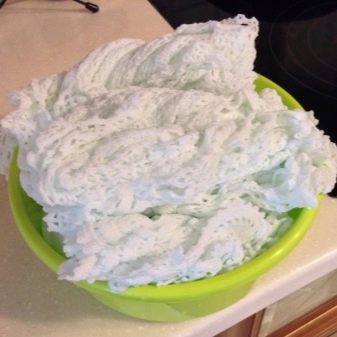
Gelatin
The use of gelatin will allow you to give the correct shape to knitted openwork products.
Preparation of the mixture.
-
Take a glass of warm water and pour 2 tbsp into it. l. gelatin. Leave on for 10-20 minutes until completely swollen.
-
Pour water into a container and put it on fire.
-
The prepared gelatin is heated in a water bath until the grains disappear completely.
-
Cool the mass to a temperature of 40 degrees.
The washed napkin is placed in the prepared solution so that it is well saturated with the jelly-like mass. The napkin is pulled out, squeezed slightly and laid out to dry.
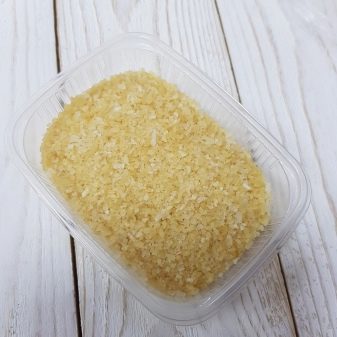

Products processed in this way are quite hard and will not crumble.
Spray can
Taking a special aerosol, you can also quickly starch napkins and other openwork products. In the composition of this aerosol there is already a paste for processing, which gives the textiles the required shape and appearance.
To starch the product you need:
-
moisten textiles with water;
-
take the pins and fix the napkin on a flat surface;
-
apply a spray to the product;
-
put on top of cheesecloth in several layers and iron.
After processing, the products will become more rigid, but they will be able to retain their appearance for a short time.
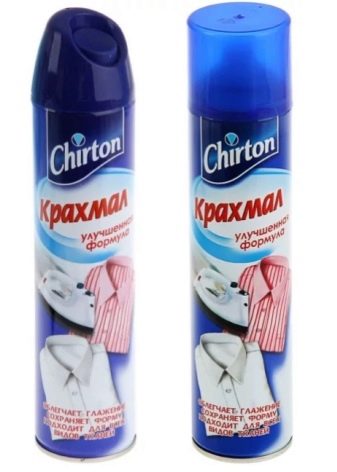
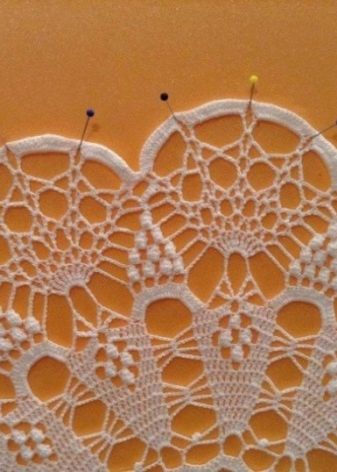
Using all of the above methods, you can starch not only knitted openwork products, but also fabric models... Clothes made of fabric, home textiles are treated with a mixture of 1 liter of water and 1 tsp. starch. Fabric products are immersed in the solution for several minutes. With weaker processing, the solution is poured into a spray bottle and the laundry is sprayed. In this case, the stage of soaking, wringing and drying is simply skipped.

It is not necessary to soak a knitted napkin. You can give it the required hardness using the dry method.
-
You should take a sheet of white paper and spread a napkin on it. For better fixation, the textiles are secured with pins.
-
Then you need to take a sieve and evenly pour starch through it.
-
Using a spray bottle, sprinkle the product with water.
-
The product is allowed to dry naturally, or it is dried with an iron through several layers of gauze.
-
The craft is shaken and the rest of the powder is removed with a brush.
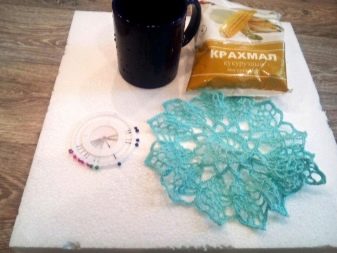
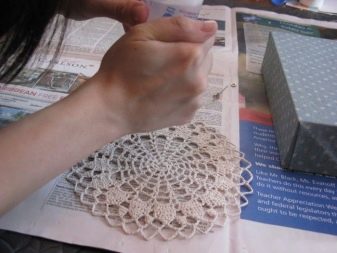
This option can be called an express method. It can be used when you need to very quickly bring the napkin into the desired form.
Useful Tips
To avoid mistakes, you should adhere to the recommendations.
-
Dry products in well-ventilated areas. It is advisable that direct sunlight falls on the napkin. In other cases, the products are dried with an iron, covering the surface with gauze or a sheet of white paper.
-
Starch-treated things it is not recommended to re-moisturize, otherwise they will lose their shape.
-
If necessary, make the napkin voluminous, giving it the appearance of a vase or plate, dry it, cover it with a film and put it on the mold. And you can also use a bowl, glass or bottle for this. To give the product a shape in the form of a wave, it is wound on a bottle or on thick curlers.
-
A balloon can be used as an original shape. You can give products to different sizes by inflating balloons of different sizes.
Laying out a napkin on a ball, you should first cover the surface with foil. Under natural conditions, such crafts can dry up to 2 days.
